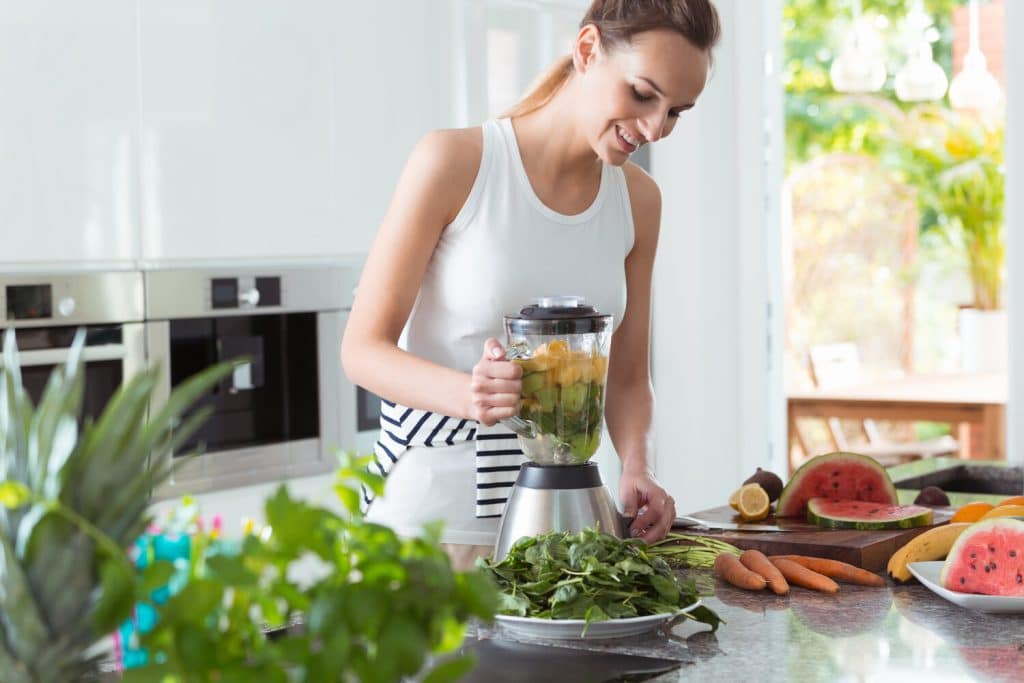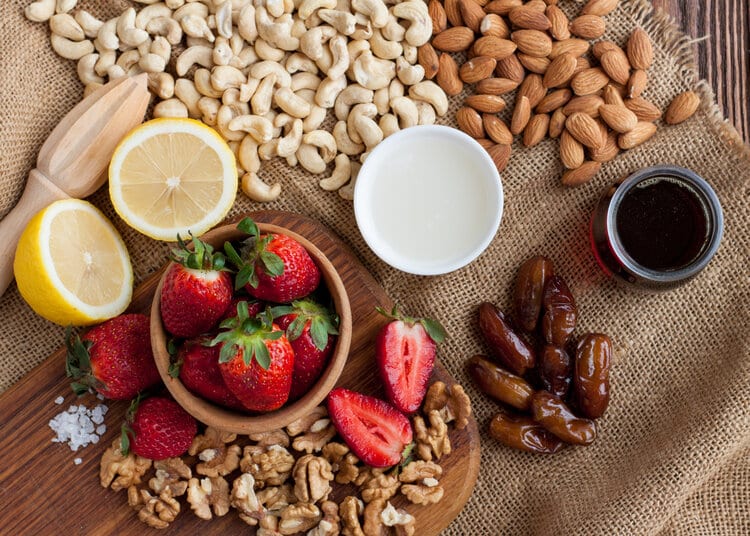How exactly do you eat a high fiber diet?
And beyond that, why should you care?
Well, you should care because fiber is a secret weapon.
If you learn nothing else from this post, I hope you learn that.
We do not absorb fiber calories, which means they are “free calories”.
Rather fiber gets shuttled down to the large intestine where your little buddies, your microbiome, feast on it for breakfast, lunch, and dinner.
And boy do they love them some fiber!
When the bacteria metabolize fiber they create a byproduct called short-chain fatty acids. Butyrate is the main one and it is a direct fuel for your intestinal cells.
This makes your intestinal cells happy and increased fiber intake is protective against the risk for colon cancer. (1)
Butyrate from a high fiber diet may also benefit brain health in the short run through better cognition and in the long run through the prevention of neurodegeneration. (2)
Not only that, fiber is associated with a healthier microbiome in general, which can benefit many, many different aspects of your health. (3)
Increased fiber intake is associated with a lower risk for heart disease, stroke, high blood pressure, GI disorders, type 2 diabetes, obesity, and certain types of cancer, including colon cancer as mentioned above. (4)
So, in most cases, eating more fiber will reap rewards in your health.
The average American does not eat enough fiber. Only about 12-20 grams per day. (5) The recommendation for men is 38 grams per day and 25 grams per day for women. (6)
I recommend that everyone gets a minimum of 25 grams per day. For weight loss I often recommend 35 grams per day or more. (but each client will get personalized recommendations)
Even my clients that come to me already eating a pretty good diet often do not get enough fiber.
So, how do you eat more fiber?

First, I strongly urge you to learn the fiber content of various foods so that you know how much you are currently consuming and how much you are adding.
Here is a list of foods rich in fiber:
- Beans and Legumes like black beans, pinto beans, chickpeas, lentils, and green peas
- Vegetables, especially cruciferous and prebiotic-rich veggies (see list below)
- Fruit: my favorites are berries, cherries, avocado, greenish bananas, & green plantains
- Nuts of all kinds
- Seeds: especially chia and flax seeds
- Whole Grains: make sure they are unprocessed, whole-grains, whole wheat is a powerhouse for fiber

So, now that you have the list, how do you eat more of those foods? You can do this by entering what you eat into a diet app. Cronometer is my favorite because it also shows you the vitamins and minerals you are consuming.
I ask all of my clients to enter what they are eating into Cronometer. Many of them are shocked to see they are eating so little fiber!
It is best to increase fiber intake slowly. If you are not used to eating a lot of fiber and you suddenly increase your intake by 10 or more grams per day, you may encounter some GI distress.
I usually recommend that my clients pick one high-fiber food that they like and add that in.
Some ideas include
- Add 1 additional TBSP of chia or flax seeds per day.
- Increase your vegetable intake by 2-3 cups per day (focusing on the high impact veggies listed below).
- Add 1 cup of berries to your daily menu (if you aren’t eating them already).
- Add 1/2 cup of legumes per day (but not peanuts, they are often contaminated with mold)
The idea is to make one change and get used to that for a few weeks.
Then add something else.
This way you are adding in fiber slowly AND you are developing a habit.
Once you are in the habit of eating more fiber it will be second-nature to you.
And I think you will see some wonderful rewards from it!
Cautions
One thing to be aware of is that if you have ongoing gas, bloating, diarrhea, constipation or other GI discomfort you may feel worse if you start increasing your fiber intake.
Please use caution if you already have those types of symptoms. You MAY have SIBO, which should be investigated.
If you don’t have those symptoms but they develop when you start adding in more fiber, that may also be a sign that you have SIBO.
If you have feel BETTER when you add in more fiber, that is good! It means your microbiome was looking for its food and you gave the bacteria what they needed. Yay!
LIST OF PREBIOTIC (GOOD FIBER) FOODS
Vegetables
- Asparagus
- Jerusalem Artichoke (aka Sunchokes, these are best raw and sliced in salads)
- Dandelion Greens
- Chicory
- Garlic
- Onions
- Leeks
- Jicama
- All Cruciferous veggies
- Arugula
- Bok Choi
- Broccoli
- Broccoli Rabe
- Brussel Sprouts
- Cabbage
- Cauliflower
- Chinese Cabbage
- Collard Greens
- Daikon
- Horseradish
- Kale
- Kohlrabi
- Komatsuna
- Mizuna
- Radish
- Rutabaga
- Tatsoi
- Turnips
- Wasabi
- Watercress
Fruit
- Berries
- Cherries
- Banana
- Avocado
Grain-Free Resistant Starches
Green mango
Green banana
Green plantains
Cooked and cooled potatoes (cool for several hours and eat cool, do not reheat)
Raw potato starch (can be added to smoothies)
Other Resistant starches
Oatmeal (cook for a few hours for more resistant starch)
Rice cooked and cooled (eat cool)
Soaked and cooked beans (cooking in pressure cooker reduces lectin)
Vegetables With High Fiber
(fiber amount per 100 grams, which the amount in ounces really depends on the food so look it up for exact amounts)
Fiber Net Carbs
Alfalfa Sprouts 2 g 0 g
Asparagus 2 g 0 g
Beet Greens 4 g 0 g
Broccoli Rabe 3 g 0 g
Cauliflower 3 g 0 g
Endive 3 g 0 g
Mustard Greens 2 g 0 g
Sauerkraut 3 g 1 g
Turnip Greens 4 g 0 g
Broccoli 3 g 2 g
Cabbage 3 g 2 g
Kohlrabi 4 g 2 g
Okra 3 g 2 g
Spinach 3 g 2 g
Artichoke 5 g 4 g
Brussel Sprouts 4 g 4 g
Jicama 5 g 4 g
Peas 5 g 7 g
- https://www.ncbi.nlm.nih.gov/pmc/articles/PMC4588743/
- https://www.sciencedirect.com/science/article/pii/S0304394016300775
- https://www.ncbi.nlm.nih.gov/pmc/articles/PMC5390821/
- https://www.ncbi.nlm.nih.gov/pmc/articles/PMC6124841/
- https://www.ars.usda.gov/ARSUserFiles/80400530/Pdf/0910/Table_1_Nin_Gen_09.Pdf
- http://nationalacademies.org/hmd/reports/2002/dietary-reference-intakes-for-energy-carbohydrate-fiber-fat-fatty-acids-cholesterol-protein-and-amino-acids.aspx
